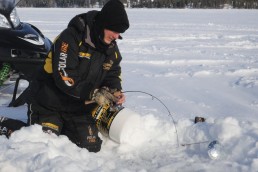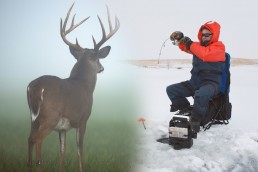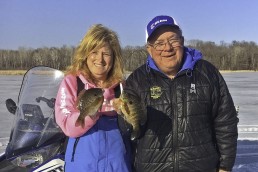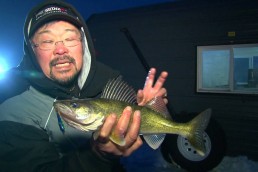Challenging Yourself to Become a Better Ice Angler
SHARE THIS POST
Most anglers have favorite waters. Preferred locations. Species. And, it’s normal for most of us to selectively develop techniques that bring success in these most-commonly encountered situations. Season after season, we refine those presentations to a higher level of effectiveness. As a result, specific strategies become favorites and our usual “go-to” methods.
Unfortunately, it’s easy to become so comfortable we overlook alternatives that could produce better results when conditions change.
This pitfall can be avoided, however, by maintaining an open mind and challenging ourselves. The trick is to expand horizons by experimenting, exploring and becoming versatile enough to read situations, then finding the courage to make changes.
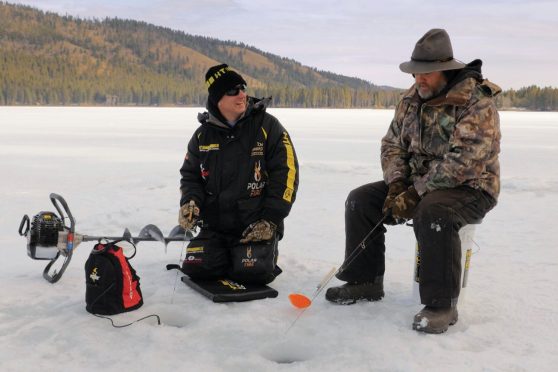
Getting out of your comfort zone
Perhaps you’re a diehard spoon-jigging freak. If so, you’ve likely got a favorite brand, model, size and color, maybe two, and a tried-and-true means of working each confidently. That’s good, but only to a point.
Being open to alternative uses—or even differing brands, models, sizes, colors and ways of working them—will not only make you more productive but foster more versatility and increased confidence.
One of the best ways to accomplish this is through the eyes of another avid angler. Invite one to visit your favorite waters. Openly share your expertise. You’ll likely find yourself recognizing subtle nuances you have been initiating without even realizing it. As a result, you’ll become a better angler simply through the process of teaching.
Then, take this up a notch by utilizing a “trade-a-trip” philosophy. After hosting your guest, allow them the opportunity to return the favor by allowing you a chance to visit their home territory and an opportunity to share their favored tactics. Be sure to take careful notes and weave them into your own repertoire.
By truly understanding a wider variety of unique situations, recognizing how these varied strategies are being used and why the techniques effectively fit the situation, you’ll gain valuable knowledge.
Simple variations, big results
Next, consider how to apply this knowledge to further expand your versatility.
Let’s stick with the spoon example. If a situation involves a tough bite and you need to slow things down, you might make only a subtle adjustment. Perhaps take your favorite model and drop down a size. Maybe try removing the hook from the base and replacing it with a dropper line extending down to a smaller, baited lure or plain hook. Your de-hooked spoon will now act as an in-line attractor.
You can work such presentations more moderately, periodically moving the attractor spoon to flash and draw fish in. Then, whenever one approaches, try gently raising, lowering or twitching the smaller, baited jig or hook placed off the dropper line. Experiment to see what action triggers the most positive reaction.
Then again, you might just as easily encounter active or hard-to-convince fish and decide you want to ramp things up. Maybe try going to a somewhat larger, perhaps gaudier-colored version of your favorite design combined with a plastic action tail, colorful spinner, blade, beads or other attractors of various composition. Then, work the whole thing rather aggressively, attempting to provoke reaction strikes.
When things just don’t go right
Be willing to open up and explore new options. Having the ability to recognize the situation and a greater array of ways to tackle it will lead to more successful days on the ice. There are now more lure choices available than ever before. Your mission can be accomplished relatively easily, simply by trying other designs that fall faster or slower, flutter or flash differently, produce distinct vibrations, rattles or varying combinations thereof.
Go a step further by adding varying jigging motions, cadences and other presentation wrinkles that add to your arsenal of tricks. Seems simplistic, yes. The truth is, most ice anglers don’t take the time to move the needle outside their comfort zones. They end up missing opportunities because of it.
Are you enjoying this post?
You can be among the first to get the latest info on where to go, what to use and how to use it!
Still not convinced?
Perhaps you’re a bona fide, dyed-in-the-wool panfish angler who has mastered the art of a tight-line micro presentation. Such techniques are sometimes so seemingly universal and become so finely tuned, it becomes difficult to mix and match presentation variables.
By following the same guidelines applied to the spoon presentations above, you must become more open. Experiment with new lure brands, models, designs, sizes, colors and ways of working them. Gain confidence and be ready when alternative methods are called for.
Consider inviting another successful panfish ice expert to visit your favorite waters. Share your expertise! You may be surprised how teaching makes you break down details and create awareness, simply by taking a closer look at exactly what you’re doing. That’s something you aren’t as likely to do when fishing on your own.
From there, trade a trip to better understand the other person’s strategies and how their approaches might evolve into ways that increase your tactical advantage. Again, variations might be quite subtle. Nonetheless, they have substantial impact.
You can always learn from your fellow outdoorsmen
Maybe your associate has developed a means of working a specially designed spring bobber to produce a unique motion to effectively trigger a reaction. Or, perhaps they maintain a cadence that assists with detecting minute strikes. Perhaps the addition of a painstakingly balanced, neutrally buoyant micro float provides a similar edge – or another barely discernable tweak that produces beneficial results.
It could be an odd shake or shimmy to produce unique motion, the way they hold their rod to obtain a better feel, the hook style they’re using. It could be the way they bend a hook point to improve hook-ups, a deadstick methodology that imparts no motion at all or perhaps a combination thereof. Pay attention! You never know what is making their method produce.
Be open minded! Ask questions, listen and observe. Such experimentation provides enhanced knowledge and opens the doors to greater versatility. Versatility ultimately brings more consistent success.
If none of those things appear to apply – or even when they do – take a little time to further check even the most minute details. What type of leader is being used? What diameter, length and color? Did you notice what type of knot they’re tying – how they tie it, and the position they’re placing it on the hook eye?
Are they adding live bait? If so, what kind? Size? Any specific color? How is that bait being positioned on the hook? Is there a specific motion or cadence they’re incorporating into their jigging action to take special advantage of this combination or enhance it in some special way?
Perhaps they’re dissing live bait in favor of plastic. If so, what kind, design, size, color? Is it a commercial model, and if so, being fished “as is” right out of the package, or has it been customized or modified in some way to create a different look or action? If you can’t identify the model, is it a newly introduced design or perhaps a unique one they created completely on their own?
Either way, how are they working it to their advantage? Are they adding anything to the presentation in the form of additional attractors or scents. More importantly, how can these concepts potentially be explored, modified and applied advantageously in similar or varying situations?
Adaptation is the key to progress
If you learn to adapt to a variety of differing conditions and situations while combining moderated presentation concepts, then modify each—always searching for wrinkles providing an edge—you’ll be employing the type of thinking necessary to explore innovative concepts. Consequently, you’ll develop truly new, revolutionary tactics and techniques that will help elevate you to another level.
This process truly makes each ice-fishing outing a more interesting, rewarding experience. Ultimately, the more strongly you challenge yourself, the more likely you are to become a better, more versatile and consistently successful ice angler.
MWO
SHARE THIS POST
Did you enjoy this post?
You can be among the first to get the latest info on where to go, what to use and how to use it!
Tom Gruenwald
Tom Gruenwald has penned hundreds of informative ice-fishing articles and blogs, been a frequent and popular guest on outdoor speaking circuits, radio and television, has authored four ice-fishing books, and formerly hosted Tom Gruenwald Outdoors, a nationally syndicated television show dedicated solely to the sport of ice-fishing.
